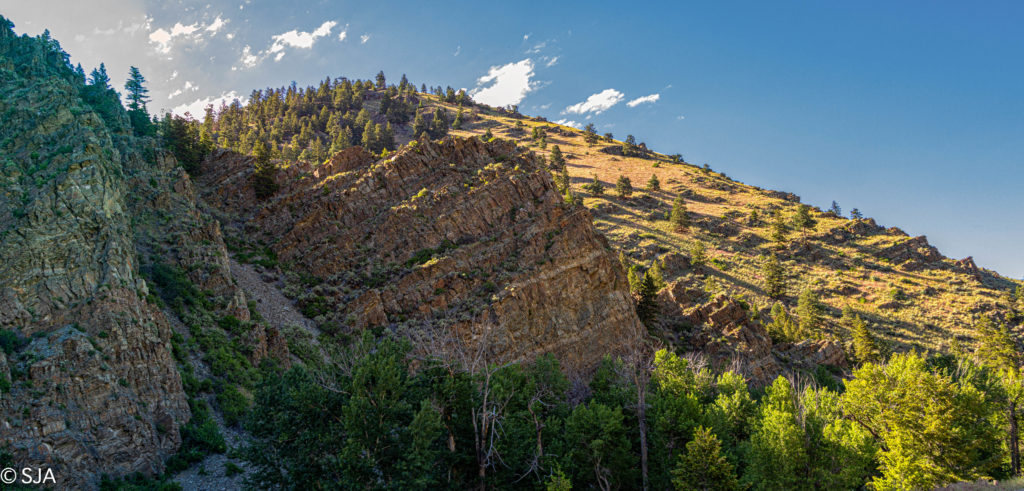The wagons rolled to a stop. The travelers must have felt overwhelmed as they came into Virginia City on September 7, 1864. This boomtown had sprung up almost overnight. Prospectors and those seeking their fortune flooded the area. Along with the wealth of the discovery of gold came a wealth of crime. Just ten days after their arrival, John “The Hat” Dolan was hung on the town gallows for stealing $700 from a roommate.

The Brannin wagons left Boonville, Missouri, in March of the same year, traveling with other pioneers headed west along portions of the Oregon Trail. Stanton Brannin was among the wagon train members with some of his relatives – Andrew & Ann Brannin Gibson, William & Sommerville Brannin Gibson with sons Henry & George, Elnora Brannin, Balsora & Dr. George Stein, Sarah Furnish, Bob Brannin and William Brannin. Mary Furnish planned to make the trip but had to postpone until the next spring due to sickness.
The wagon train followed the Missouri River, through Platte River Valley, Ft. Laramie, Sweetwater River, Landers Creek, Bear River Mountains, into Portneuf Canyon near Pocatello, Idaho and Fort Hall. Elnora added that they came by way of “Sanders Cutoff, which was considered a very dangerous route at that time,” and passed by the foot of Blue Mountain. They traveled through the Bear River Mountains of which she said, “the road was so steep and rugged we had to walk the greater part of the time.” Aunt Elnora gave a written account of some of the atrocities they saw.
After camping at Fort Hall, Idaho, the wagon train split up. Cousins Bob & William Brannin traveled on to Oregon. The other Brannin relatives took the road north to Virginia City, Montana.

They were soon part of the raw, tough and tumbling Western boomtown. The Gibson’s ran a boarding house on Idaho Street for a couple of years. The newspaper recorded the grand parties they hosted in December of that same year. William Anderson Clark, the Copper King, described as “the most powerful, influential, and ruthless of the 19th century American robber barons,” was a visitor at the boarding house before he rose to such power and wealth.
Some of the family remained in Virginia City until the Spring of 1865 when they went to Blackfoot City and spent the summer. They moved on to Helena in December and stayed the winter. Sarah Furnish married Wilson Redding. He discovered the Hot Springs at Alhambra. He and his bride, Sarah Furnish, opened the Alhambra Hot Springs & hotel. It was a flourishing business for several years.
It wasn’t long before the Gibson’s moved closer to Helena at Gates of the Mountains where they managed the King & Gillette Toll Road that led from Ft. Benton to Helena through Prickly Pear Valley. Naturally, the Gibson ranch was a perfect stopping place.

The Gibson ranch was described by some its guests:
“Just at the mouth of the canyon, on this side, we found a spot that all, even the grumblers, were in love with. For a great distance on both sides of the stream, a thick growth of trees and underbrush presented its dark green foliage to the view, while on either side the beautiful valleys hills and mountains caused many an exclamation of admiration from those just from the States, who had never seen the like before. Here is Gibson’s ranch which we must say, is the neatest place in the country. As one sits down to the table there, and luxuriates on sweet milk, nice butter and Dutch cheese, and sees the elderly people about him, trying to do all they can to make him perfectly at home, he goes back in memory to the days of childhood when he used to disturb the cream on the milk in his grandmother’s pantry, and not get much of a scolding for it either. Fishing and hunting are “in order” near Gibson’s and we know of no better place at which to spend a few days or weeks for summer rustication.”
Post, June 29, 1867

“At a time when they expected it not they seem to have “passed through Switzerland,” as some of them have pointedly expressed it. And here, in this connection, we will remind our friends that they can find no better place at which to spend a few hot summer days than at this same Little Prickly Pear Canyon. Gibson’s ranch, at its mouth a combination of neatness and good cheer offers a convenient stopping place for all who would enjoy the pleasure of hunting and fishing amidst the grand towers and groves of this mountain nook.”
Montana Post, June 26, 1868


By 1870 the Gibson’s were back in Missouri. The return to their home state did not deter Stanton Brannin from his adventures. He made his way to New Mexico where he married and started a large family. It seems that the Montana mountains continued to call his name. In June 1896, on their way to Marysville, they arrived in Helena just in time to witness the hanging of William Gay who claimed innocence with his dying breath. When the wagons rolled to a stop, some of the family may have felt just as overwhelmed as the Brannin relatives did when they arrived in Montana the first time thirty-two years earlier.

Your best story yet! And you just scratched the surface of the Brannin story.
Thanks. There’s lots more!
Good to hear the Stanton side. Very compelling.
A story looks different if you’re the one in the middle of it.
Awesome! So glad we’re connecting about your incredible family history 🙂
Jamie Guenther
Jefferson County Museum
Trustee, Board of Directors